The Palestinian shibbabeh – an in-depth study of this instrument and its history
 This article by Ruud Bemelmans has an interesting story behind it. Ruud, originally from Holland and living in the United Kingdom, is passionate about music. He has been blind since he was fifteen, and in his own words, ‘sound became more important, and so did music’. He contacted me a few months ago about the Palestinian shibbabeh, a traditional instrument that I use quite a lot in my music, and have published quite a bit of information about, including tutorials. He wanted to own one, so I hooked him up with Pamela Feyrouz from the Netherlands, who manufactured a few of these flutes for him according to the instructions that can be found on my website. I was pleasantly surprised by his increased interest and comments on the importance of the shibbabeh to Palestinian heritage and culture, but I was absolutely impressed when he wrote this treatise on the instrument and published it on his website. It has been reproduced here with his permission, and the original can be found here. I absolutely recommend that you read it, and share it widely. Thank you, Ruud, for your awesome work! – Doc Jazz
This article by Ruud Bemelmans has an interesting story behind it. Ruud, originally from Holland and living in the United Kingdom, is passionate about music. He has been blind since he was fifteen, and in his own words, ‘sound became more important, and so did music’. He contacted me a few months ago about the Palestinian shibbabeh, a traditional instrument that I use quite a lot in my music, and have published quite a bit of information about, including tutorials. He wanted to own one, so I hooked him up with Pamela Feyrouz from the Netherlands, who manufactured a few of these flutes for him according to the instructions that can be found on my website. I was pleasantly surprised by his increased interest and comments on the importance of the shibbabeh to Palestinian heritage and culture, but I was absolutely impressed when he wrote this treatise on the instrument and published it on his website. It has been reproduced here with his permission, and the original can be found here. I absolutely recommend that you read it, and share it widely. Thank you, Ruud, for your awesome work! – Doc Jazz
The Palestinian shibbabeh – by Ruud Bemelmans
In mid may 2014 I became interested in the shibbabeh and, as I tend to do with any instrument I wanted to learn more about it. I discovered straight away that this wasn’t going to be a simple bit of research and decided that I was going to take notes. For the past three months I’ve made it into a personal project to gather and organise the available information about this instrument and its role in Palestinian music. However, due to the scarcity and fractured nature of the resources I’ve had to work with I had to create a coherent whole out of hundreds of pieces, which had to be verified and related to each other. More than halfway into the project I began thinking of sharing it online in the form of an article, so other people would be able to benefit from what was already promising to become the most comprehensive information written in English about the shibbabeh and how to play it. This changed the whole outlook and format of the project, specifically in terms of providing concise explanation without losing focus of the practical.
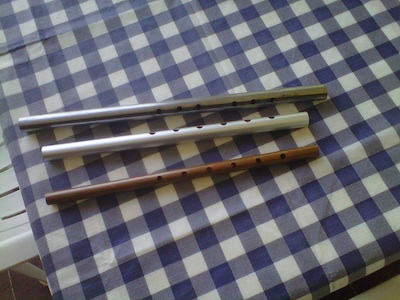
Pertaining to the shibbabeh’s playing technique, of which almost nothing could be found I have been using my experiences and knowledge of the Turkish ney and other open-ended flutes to get an idea of what is possible with a flute of this particular type and cross checked their applicability with the few very minor references regarding the shibbabeh and its traditional usage. The last step in this process was experimenting on my own two shibbabeh, so I could be absolutely sure I would be able to confirm every word I’ve written regarding playing technique.
At other points I’ve attempted to fill in gaps with assumptions based on comparisons and logical reasoning, relying heavily on my knowledge of many musical instruments. Therefore I can’t claim that all the information presented here is accurate, however I believe the vast majority is. I hope that I, or someone else, will be able to expand on this article and correct potential false assumptions. For the purpose of this article I’m using the spelling shibbabeh for both singular and plural, as I’m not quite sure whether alternative spellings match the Levantine Arabic dialect as spoken in Palestine or how to correctly pluralise the name.
Introduction
The shibbabeh (alternative spellings: shabbabah,, shubbabah, shebbabi), approximate pronunciation: shib-beh-buh, is a short open-ended flute from Palestine that shares its folkloric and pastoral heritage with most other open-ended flutes found around the Mediterranean (Turkey, North Africa and east Europe), Ethiopia, The arabic peninsula and central Asia (Siberia and Mongolia). When the open-ended flute migrated from Siberia to the Americas it underwent significant changes in appearance and use, hence why I’m not directly relating the shibbabeh to the open-ended flutes found in the broken flute cave (Arizona) which were played by ancestral pueblo peoples.
N.B. The migration of the open-ended flute from Siberia to the Americas is only a theory, which happens to be the one I subscribe to. This does not mean that I discount the possibility of open-ended flutes having been invented and developed simultaneously by cultures that were isolated from one another. In fact there’s a reasonable probability that this occurred in Ethiopia, Sumeria and central Asia.
In Yemen a flute that’s also called shibbabeh appears to be a regional variant. Other similar flutes are the minjayrah (Lebanon, Syria, Iraq) and the kawala (Egypt). The latter has become an integral part of sufism, whereas the Palestinian and Yemeni shibbabeh and the Lebanese, Syrian and Iraqi minjayrah retain their pastoral and folkloric connections. In north Africa and southern Spain similar flutes are known as axabiba, exabiba, ajabiba and xabiba, which etymologically link back to “al shabbabah”, meaning the small one or the young one. There are also references to a qassaba, qasbah or gasba, however this term seems to get used for various flutes. In northern Africa it commonly refers to the nay/ney, whereas on the Arabic peninsula it can refer to a nay/ney as wel as a smaller reed flute, which is possibly similar to the shibbabeh.
History
The shibbabeh’s origin and history are vague at best, however resources hint that flutes known by the same name and with similar features were played in the region 2000+ years ago and that it was a popular instrument during the middle ages. It is worth noting that the only feature of the shibbabeh, which may have changed over time is the scale. This is based on the fact that many Maqam have been lost after decennia of disuse, even if they were very popular at one point. However, it’s very probable that the shibbabeh’s origins are much further in the past. This is merely a hypothesis based on the extremely basic construction method still used for the instrument today, the fact that it was an instrument played by shepherds, bedouin and other lower classes of society and that the material used historically is biodegradable if left to the elements.
We know the oldest written record that mentions” flute” dates back to 2600 BC from a Sumerian tablet. There are numerous Egyptian, as well as Sumerian depictions of open-ended reed flutes being played about 5000 to 4500 years ago. The nay/ney dates from this period and is thereby the oldest known flute that is still being played today. On the other hand, there are theories that the nay/ney evolved from a smaller open-ended flute, usually the Ethiopian washint, Egyptian kawala and east European or Turkish kaval get mentioned as examples. In the previous section the kawala was mentioned as a similar flute to the shibbabeh. Stating definitively which flute preceded the other is impossible as no archaeological finds have unearthed evidence to support this theory and very likely never will.
Construction
The shibbabeh is about 30 to 40cm long and has six finger holes that produce a full scale. Historically it was made from reed (arundo donax) or wood, but it seems more common to find metal or plastic versions nowadays. The metal flutes, generally aluminium or copper can be affected by temperature and moisture resulting in muted or hoarse sounds. Plastic instruments don’t suffer from this particular defect, which makes them highly suited for long playing sessions without compromising on tone and volume.
Based on references to the persian ney and other flutes developing cracks when played directly on the reed due to moisture and warmth from the breath, it probably meant that reed shibbabeh had a limited life span. This isn’t unheard of with shepherd’s instruments and may be another compelling reason for the switch to metal, and later PVC when these more durable materials became available.
Most open-ended flutes have a specifically designed blowing edge to help split the air and create the desired clarity and volume. The shibbabeh, on the other hand, doesn’t have this feature and it can be presumed that historically reed or wooden shibbabeh didn’t have this either.
Below is a picture showing a Turkish kız ney; thick arundo donax with a delrin başpare (lip rest), a low Turkish kaval made from plastic and two PVC shibbabeh of different sizes. On both the ney and kaval you can clearly see that the blowing edge has been shaped, whereas the shibbabeh haven’t.
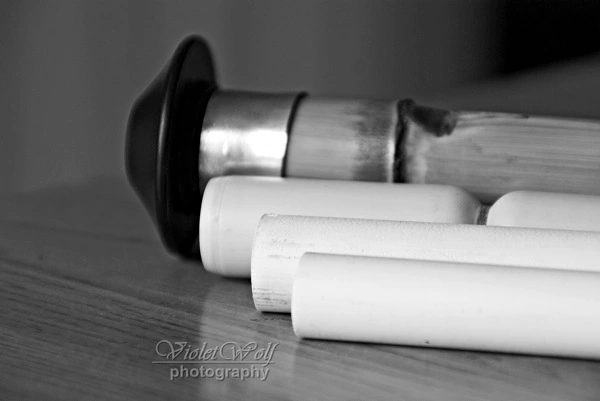
Positioning
When playing the shibbabeh the air column is directed to either the right or left side of the blowing edge, roughly between 2-4 or 8-10 o’clock. This section of the flute has to be in front of the centre of the lips, where the embouchure will be formed. This usually means, depending on the diameter of the flute that the opposite side rests against the corner of the mouth. The shibbabeh is not held pointing directly forward, but obliquely. If the right hand is the one covering the bottom three holes the flute is placed in the right corner of the mouth and is held approximately 30-60 degrees to the right. This basic positioning will get adjusted until a clear tone can be achieved.
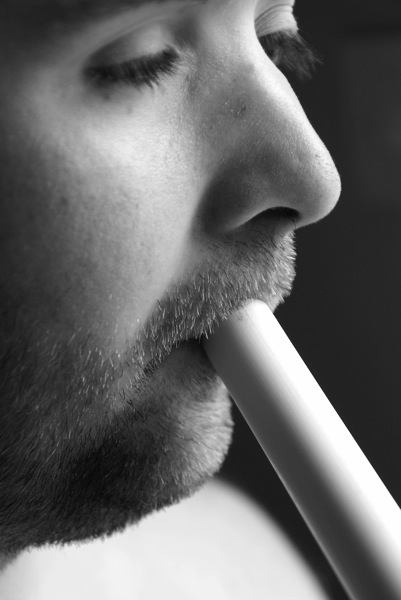
Sound production
Sound gets produced by directing a concentrated air column onto the inner edge of the tube with the lips shaped similar to whistling. This is called bilabial blowing. This method of sound production is very common with open-ended flutes, however it’s not an easy technique. Beginners may take weeks or months to get a clear sound, which will slowly develop the more they play. As the name indicates the lips are vitally important, however so is the control of the tongue, throat cavity and diaphragm. Slight changes in any of these will alter the timbre of the instrument. The aperture between the lips should be small, a few millimetres in diameter, to help control and direct the air stream onto the blowing edge.
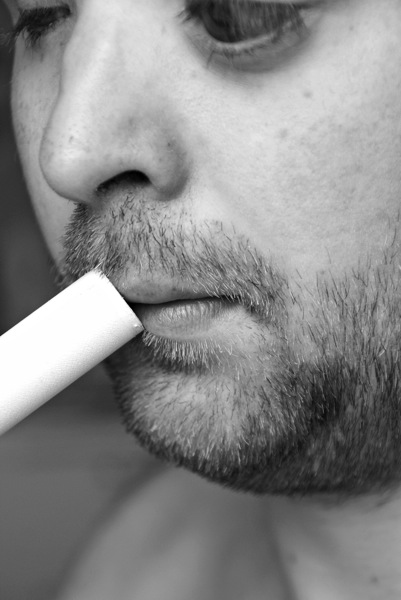
Proper breathing from the diaphragm is essential when playing the shibbabeh. Dizziness and the inability to maintain a sound for longer than 15-twenty seconds are good indicators of problems with breath control. Breath directly influences good tonality, but also contributes to playing in pitch as a softer breath will produce a pitch that’s slightly flat. This however can be used to great effect when reaching the end of a phrase and creating a descending cadence by reducing the breath gradually. This is a very common feature in shibbabeh playing and happens almost automatically before taking another breath. The optimal sound and volume has been achieved when the flute, as well as the air inside can be felt vibrating against the thumbs and fingertips.
The shibbabeh, by its very nature, produces a sound with a degree of breathiness. From a western point of view this isn’t preferable in any wind instrument as it may hint at a low quality instrument with potential construction flaws. During the 20th century a number of open-ended flutes have been “modernised”, which included increasing clarity by reducing breathiness. The Bulgarian kaval is a good example of this. However, it’s a myth that breathiness has a negative effect on a clear strong tone. In fact, the amount of breathiness can be controlled, but not completely eliminated, and it can even be used to great effect in one’s playing. The breathiness is a definite part of why open-ended flutes are so wonderfully evocative of pastoral or nomadic scenes.
Range
The shibbabeh has a tonal range of an octave and a minor seventh. This doesn’t seem like a lot compared to most western music, however we’re dealing with a simple folkloric flute which tends to play melodies that generally have a small range of less than an octave. In a small flute like the shibbabeh registers and octaves are almost synonymous as the full range can be obtained within two registers. When talking about registers I’m referring to the various tones you can achieve by overblowing, so the first register with all holes closed produces the fundamental pitch, the second produces the octave of the fundamental, the third produces a perfect fifth and the fourth produces another octave. This concept is used in almost all open-ended flutes. Most of them are medium in size (45-65cm in length) and capable of playing comfortably within three or four registers, some longer flutes even up to six or seven.
Scale
The shibbabeh’s scale is called maqam bayati, which is one of the most popular scales in folk, as well as classical Arabic music. In a folkloric context the name of the scale and its theory doesn’t really matter as long as the player is familiar with the intervals. Let’s, for sake of simplicity state that every single shibbabeh is tuned to D and uncovering the holes one by one will produce the scale: D, E half flat, F, G, A, B flat, C, D, with the intervalic ratios of 3/4, 3/4, 1, 1, 1/2, 1, 1.
Most of these tones are easy to understand, aside from E half flat, which indicates that the tone produced is somewhere between E flat and E natural. People with western musical knowledge will probably have noticed that it’s almost a D natural minor scale, with that one exception. In essence this is true, however the Arabic musical system is based on the harmonic series and therefore uses true temperament rather than equal temperament, which means that some other notes can be half flat or sharp, but since that’s their natural state it doesn’t get mentioned.
A feature of Arabic music that may be confusing to people with western musical knowledge is that the scale is by no means static. It is for instance very common to have a difference between whether a phrase is played ascending or descending. As mentioned before in a folkloric context the theory doesn’t matter, as long as the idea is understood and it can be put into practice successfully.
In Maqam bayati when descending from B flat we will get: B flat, slightly flat A, slightly flat G, slightly flat F, E flat, D natural. All the notes in between B flat and D are flattened slightly and the E half flat will be changed to an E flat. To simplify this when ascending the scale is played naturally, but when descending all of the notes except the fundamental will get flattened slightly. This can be accomplished by bending, which is done by changing the angle of the flute or turning the head. When decreasing the distance between embouchure and the place where the air column hits the edge the tone will fall, whereas when you increase the distance between the lips and edge the tone will rise. What this means in terms of playing the shibbabeh is that you establish a natural position when playing ascending phrases, and reducing the angle of the flute or turning the head slightly to decrease the distance between lips and the edge when playing descending phrases.

N.B. Bending is an essential technique as it will have other uses as well. These will be discussed further on. It’s advisable to practice bending notes up and down as far as you can without losing sound. The shibbabeh, depending on diameter should be able to bend roughly a semitone in either direction. Experienced players of open-ended flutes can bend notes by adjusting their lips, tongue, throat and/or diaphragm as well, but this requires extensive practice. It’s a curious fact that once familiar with the flute and the playing techniques that thinking of raising or lowering a tone helps in making the correct adjustments.
Phrasian playing
In most folk music that features an open-ended flute they do something that’s known as phrasian playing. This means that bars or measures have no significance, but the importance is on melodic phrases. The breath is held throughout the entire duration of a melodic phrase. after which the player can take a breath before moving on to the next one. Sometimes rests are used as extra opportunities for breathing. Thinking of this as singing through the medium of a flute may give a better idea of how this works in practice. Since the breath is constant, repeating Notes are separated by tapping or cutting, which produces a quick grace note in between them. Some people prefer to do so using only the index fingers, others may prefer to tap the hole that’s sounding or the one directly above it, yet others combine these techniques. These are all viable methods and will produce the same overall effect, yet slightly different in terms of sound and style.
Tonguing
Tonguing notes or starting the notes with a “tah” sound is a very controversial topic for most open-ended flutes and is heavily frowned upon in some traditions. However, it’s a common feature for shibbabeh as a tool to provide a rhythmic quality to the melody or to mimic sun words starting with a strong consonant sound. This may appear to contradict the notion of phrasian playing, but in practice the phrase and breath will be maintained, even when including tonguing.
Ornamentation
Like with most middle eastern music ornamentation on the shibbabeh is kept to a minimum. The most common forms that occur quite frequently are slides and warbles, though these are more imitations of vocal music rather than actual ornamentation. Slides are either achieved by gradually covering or uncovering holes, or through bending. Warbles are achieved by tapping a single hole rapidly or playing several notes in quick succession.
Earlier in the section on sound production and scale there were mentions of the lips, tongue and throat being able to alter the timbre or pitch of the instrument. The lips can affect the pitch being played by being tightened or loosened. Tightening the lips will raise the pitch and loosening them will cause it to drop. Loosening the lips is another method of producing a descending cadence. The throat and tongue’s methods of altering volume, timbre and pitch are much harder to describe in detail as they vary from person to person and involve micro-adjustments. Experimentation and listening to the resulting changes is the only way to explore this side of shibbabeh playing.
Vocal drone
A common feature found in open-ended flutes is the addition of a vocal drone, which offers the possibility for a rougher sound. This style of playing is heavily associated with shepherds and nomads. The effect is achieved by humming into the flute while playing. Conceptually this technique seems simple, however the air stream should in no way be diminished. A slight throat constriction may help in maintaining the air stream while humming. This is a method preferred by a number of traditions. The pitch of the vocal drone is important as is the flute being played. There are two types of vocal drone, fixed or synchronised. In fixed vocal drone the player holds the pitch of the hum steady on one of the notes produced by the flute, usually the fundamental, whereas in synchronised vocal drone the player hums along with the melody while he or she plays. Which method gets used depends on personal preference and style. Playing with vocal drone is easier to accomplish on shorter flutes, like the shibbabeh, minjayrah, Bashkiri kurai, Bulgarian, Macedonian and Turkish kavals (key of C, D or E) and Mongolian tsuur. Some of these flute examples are rarely heard played without vocal drone. On the other hand it’s extremely rare to hear it being performed on longer flutes like the nay/ney.
Circular breathing
Circular breathing is a technique that facilitates a continuous air stream and therefore sound when applied to a musical instrument. This technique is commonly associated with the didgeridoo, however it’s also a feature of open-ended flutes like the qasba and kaval. It’s unknown whether it has been used on a shibbabeh, but it’s at least conceivable that some players may have done so. In short, circular breathing is achieved by inhaling through the nose while the cheeks push the air out that has been collected in the oral cavity. When performing circular breathing on an open-ended flute it’s essential that the speed of the air column stays even or else loss of sound or overblowing will occur. The concept is fairly simple, however the practice of it isn’t.
N.B. I’m fully aware that the previous section contains a lot of information and may make the shibbabeh seem like a very difficult and challenging instrument. I won’t deny that it isn’t, however if you take things slowly, starting with positioning and creating sound, then moving onto scale, etc. it should be manageable. It may take a while to learn the shibbabeh, but in the end it’s very rewarding. Besides if you can get a decent sound on the shibbabeh you can get a decent sound on pretty much every flute, with the exception of the Persian ney, Mongolian tsuur and related flutes, which use an interdental method of sound production.
The following section only has real value when you are capable of producing a near-optimal sound on the shibbabeh. Normally you’d expect an earlier mention of checking whether the tuning of any given instrument is correct and how to determinn whether this is the case, however the nature of the shibbabeh prevents doing this.
Checking relative tuning
It’s possible to check whether the shibbabeh is in tune with itself. By far the best method is by learning and playing traditional melodies, listening for notes that are out of tune relative to others and adjusting as needed.
Another method to check whether most of the scale is correct is by playing all the notes, except two and six: D, F, G, A, C, D. This is the minor pentatonic scale, by far the most ubiquitous musical scale used all over the world, with a very recognisable sound. Check the sound against another instrument by playing this minor pentatonic scale and then repeating it on the shibbabeh. The point is to listen to the intervals rather than the actual notes and comparing those. The F on a shibbabeh tends to sound slightly sharp compared to the same note on another instrument, but this is the only exception.
Provided you can reach the third register, keeping all holes closed and playing the third note up by only changing the intensity of the breath you can check the intonation of the fifth in the second register, which is the first overlapping note that occurs in any open-ended flute. The fifth is a very stable interval in most musical systems. Keep in mind that the breath and other factors can influence pitch on an open-ended flute, so if it sounds like the fifth in the second register, played by opening the four bottom holes, doesn’t exactly match the third register all holes closed there may be other reasons than the flute being out of tune. A factor that may also make it seem the note is out of tune, is the noticeable change in timbre between the second and third registers. This innate feature of overlapping notes can be used in distinguishing between two or more of the same notes and is extremely common in, for instance Bulgarian kaval, Turkish ney, etc..
Correcting pitch
As we’re dealing with a flute, which has no standardised sizes and measurements, and is generally made by people, who may not have the relevant theory of intervalic ratios or how to fine-tune an instrument, holes may be slightly off, and thus produce pitches that are near, but not perfectly in tune. In western instruments this would be considered a flaw that would need immediate correction, but in the context of a folkloric flute this is perfectly acceptable, especially since the nature of the shibbabeh allows you to fine-tune notes by several means; partially covering holes, adjusting lip, tongue and throat, or bending up or down by turning the head or tilting the flute itself. Unfortunately this adds to the overall difficulty of the instrument, but it’s not unheard of in other open-ended flutes either.
Introduction to Palestinian music
The majority of palestinian music shows a surprising freedom in terms of being able to use different words, provided they fit in a certain structure or melody. Any lyrics will, by definition, be highly poetic. Some of these poems are traditionally pre-composed or improvised on the spot in either classical or colloquial Arabic. Some of these musical forms or melodies are so ubiquitous that they transcend borders. Traditionally these musical forms can be heard at weddings, parties and other special occasions. An ensemble can consist of a vocalist, a shibbabeh or other wind instrument (for instance a mizmar), an oud, and percussion in the form of a darambuka or dumbek.
Below I will give descriptions of some of the popular or most commonly heard forms of Palestinian music. However, the best thing to do if you want to learn these on a shibbabeh is to listen to several examples, no matter if their vocal or instrumental performances or not, and then imitate what you’ve heard. In this manner you will actually be approaching Palestinian music in a traditional way as, to my knowledge, the way of passing on melodies or whole songs is largely based on imitation without any teaching of underlying musical theory.
Mawwal
Most songs will be preceded by a mawwal, though it can also be used as a stand-alone genre. The mawwal is often thought of as a eulogy because of the wailing quality, however this isn’t always the case. A mawwal consists of four or seven lines of non-metric poetry in the local dialect. The standard format is that the phrase gets sung in a staccato manner with vary little range, but the last syllable’s vowel sound gets held, sometimes as long as the breath allows. During this extension the vocalist has the opportunity to show off their virtuosity by executing scale runs and modulations to other maqam without breaking up the sound. Wind instruments are by far the most convincing when it comes to playing a mawwal. This is most likely because in both a vocal or flute performance the breath is an aspect that dictates the length of the phrases, whereas a stringed instrument could go on indefinitely. When playing a mawwal on a shibbabeh the structure of a vocal performance gets imitated, however since the shibbabeh is a folkloric flute rather than a classical one modulation to other scales can be done, but isn’t required, nor does the exact format have to be strictly adhered to.
Ataba
One of the most popular musical forms in Palestine is the ataba. It consists of a quatrain with specific rules, such as that the first three lines have to end in a homonym, each time meaning something different. The last line has to end with a specific sound, like -aab or -awa. For example:
naseem eblaadna lal-jesem mon’esh
bedoon el-waTan iqna’ yowm ma n-‘eesh
bebky eT-Teir eTha benTarad men ‘esh
fa keef el-waTan elly loo S-Haab?
The breeze of our homeland revives the body
And surely we cannot live without our homeland
The bird cries when it is thrown out of it’s nest
So how is the homeland that has it’s own people?
betaali l-leyl shaddoo ‘aa reHalhom
Hebaaby jarraH eqleaby raHeelhom
wa kam maktoob min eedy raH elhom
wa la maktoob raddoo lee jawaab
At the end of the night, they prepared for departure
My loved ones whose departure wounded my heart
How many letters, from my hand, went to them
And no letter from them to reply to mine
jama’na ed-deen bed-donya o lamm-na
o lagheir Allah ma neshkee alamna
o mahma n-‘eesh marje’na ila m-mna
areDna l-ghaalye emm en-nasab
Religion has contained us in life
And only to God we complain about our suffering
No matter how long we live, we’ll go back to our mother
Our dear land the mother of relationships
When playing an ataba on a shibbabeh this rhyming scheme doesn’t apply, however the feel and rhythmic component of the song has to be implicit, wether it’s talking about love or grief, which are the two most common subjects of an ataba. Other subjects sung about can be patriotism, anger, morality and natural features or phenomena. Commonly an ataba doesn’t have a lot of range melodically, perhaps five or six notes in total, with a start nearing the top of this range and ending on either the lowest or second lowest note. Most notes are played staccato. Descending phrases are extremely common and rhythmically some syllables, or notes in case of an instrumental version, get stressd to indicate rhythm. When a shibbabeh or other instrument gets used to accompany a vocal ataba the whole range of the flute becomes available and follows a question-and-answer-style scenario where the shibbabeh echoes the sung phrases or improvises in between them.
Ataba isn’t a form of music exclusively for men as other sources may claim, however it is a fact that vocalists are predominantly male. A common feature of female ataba is zagareet or ululation. This is a vocalisation that expresses joy or approval. Some male vocalists do zagareet as well, however in terms of timbre the brighter and higher female voice suits this vocalisation much better.
Mijana
If the ataba is like a verse then the mijana is the matching refrain, though not compulsory. Often the lyrics for the mijana are agreed upon beforehand so that other singers and musicians can join in. The mijana will be a more legato dance tune rather than the mainly staccato ataba and will often include percussion or clapping. Either when accompanying singers or when played solo a shibbabeh will always play the full melody of the mijana. When there are numerous repeats of the melody the shibbabeh player can decide to mix things up a bit by playing selected phrases or the whole melody in the second register. In a solo setting minor variations are also possible.
N.B. Sometimes artists specifically mention that they’ll be doing a mawwal, ataba and mijana, or a mijana and ataba, yet it’s also quite common to hear the usage of the word ataba as an umbrella term when referring to a song containing these three forms, especially in a solo setting where no arrangements have to be made beforehand about structure, etc.
Dal’ona
Another popular melody is the dal’ona. It’s similar to the ataba in terms of having the same structure based on a quatrain, but without the complicated rule of the first three lines having to end in a homonym. The only rule for a dal’ona is that the last word of each quatrain has to end with the sound “on a”.. The common topic of dal’ona is love. For instance:
ya Teirin Taayir fissama il-‘aaly
sallim ‘al-Hilw il-‘azeez il-ghaaly
wismik ya rooHy mayrooH min baaly
imqayyad ‘ajbeeny bein li’yoona
O, flying bird in the high sky
Say “hello” to the dear sweet one
Your name, my soul, will stay in my mind
Written on my forehead between the eyes
yally marreity o beidik sallamty
asraar il-maHabby ibqalby ‘allamty
ismi’it Sootik lamma itkallamty
bulbul beyghanny fooq el-zaytoona
O, you who passed by and waved with the hand
You marked the secrets of love in my heart
I heard your voice when you talked
Like a bird singing on top of an olive tree
Being a dance tune it’s more rhythmically defined than an ataba and often features percussion. The dal’ona is the main melody associated with the dabke, which is a modern circle-line dance involving stomping and clapping. Dabke is very popular in Palestine, Lebanon, Syria, Jordan and Turkey. A shibbabeh will generally play the melody in the second octave, which is louder and more uplifting in timbre. Furthermore this helps in staying audible above the vocals, percussion, and stomping and clapping by the dancers.
Jafra
Jafra is a popular dance melody that, like the dal’ona has associations with the dabke. In this case there’s a story that explains the origin of this melody about a poet falling in love with a girl whom he refers to as jafra. This reportedly occurred in the 1930s, so it’s a fairly modern form of Palestinian folk song. The poems became so well known that others started composing lyrics to the same melody. Like with the dal’ona the shibbabeh plays the melody of the jafra in the second register.
N.B. Aside from the dance the term dabke can also be used to indicate a session of various traditional Palestinian melodies in which a singer may take his cue from the shibbabeh and vice versa. This fluid setup seems quite common between one vocalist and one musician. When performing actual dapke melodies the audience is of course entitled to start dancing whenever they feel compelled to do so.
Of course there’s much more to Palestinian music beyond these short descriptions and examples. However, this should be sufficient as an initial introduction, as well as a stepping stone for further exploration.
Despite the difficulties with resources as described earlier, and the many many hours spent on taking notes, checking, comparing, correcting or elaborating, and repeating this process all over again, and finally writing, , proofreading and editing this article, I enjoyed this project very much and hope it will be of value to you, regardless whether you’re just interested or want to learn to play the shibbabeh, which I consider to be Palestine’s unacknowledged national instrument. I feel that it would be an absolute shame to allow an instrument, which has passed the test of time and has been mostly unchanged throughout to be lost.
The photos included in this article are courtesy of Emily Bemelmans with the exception of the first one, showing three metal shibbabeh, which was included with the kind permission of Tariq Shadid. I would also like to thank Pamela Feyrouz and John Schucker for their invaluable contributions.
This article may be distributed freely under the sole condition that it must be shared in its entirety; no parts may be altered or left out, including mention of credits and source URL.
– Ruud Bemelmans



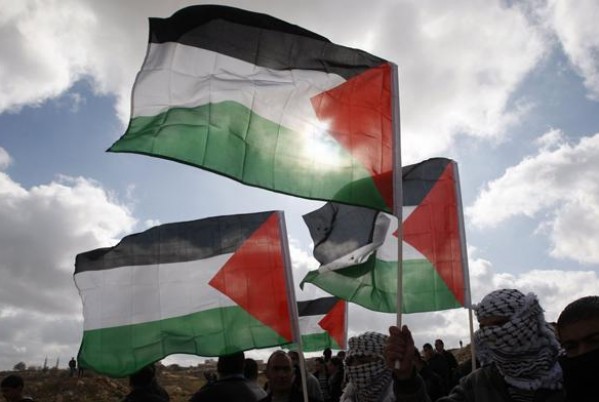
Recent Comments